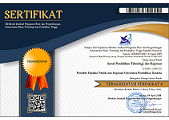PENGENDALIAN MOTOR INDUKSI 3 FASA DENGAN BEBAN DINAMIS KONTROL PID FUZZY MENGGUNAKAN METODE FOC-TAK LANGSUNG (INDIRECT FIELD ORIENTED CONTROL) PADA LABVIEW
DOI:
https://doi.org/10.23887/jptk-undiksha.v19i1.45351Keywords:
PID, Fuzzy, FOC, Induction motor, Dynamic loadAbstract
This research includes the design of a PID speed control simulation combined with Fuzzy Logic Control as a control, and increasing the speed performance of an induction motor in LabView. The control method used is a vector control induction motor, namely Field Oriented Control. This method can set up an induction motor as easily as a separate amplifier DC motor. Fuzzy Logic Control with its advantages acts as a scheduler for the PID value with the advantage of increasing the dynamic performance of the induction motor against changes in load and speed changes. From several simulations carried out on LabView with 5nm and 9nm dynamic loads using the FOC method, the average risetime result is 80% fast. When testing the dynamic load control performance, the results of the PID-Fuzzy method are better than conventional PID, especially at high motor speeds and nominal loads. In dynamic load testing, PID-Fuzzy is also better than conventional PID. With a conventional PID controller when the load is 9nm with a set point of 1500 RPM, the risetime is 10.0 ms and the steady error is 1.8%. With the PID-Fuzzy method, a risetime of 6.6 ms is obtained and a steady error of 0.7.Downloads
Published
2022-04-10
Issue
Section
JPTK
License
Authors who publish with the JPTK agree to the following terms:- Authors retain copyright and grant the journal the right of first publication with the work simultaneously licensed under a Creative Commons Attribution License (CC BY-SA 4.0) that allows others to share the work with an acknowledgment of the work's authorship and initial publication in this journal
- Authors are able to enter into separate, additional contractual arrangements for the non-exclusive distribution of the journal's published version of the work (e.g., post it to an institutional repository or publish it in a book), with an acknowledgment of its initial publication in this journal.
- Authors are permitted and encouraged to post their work online (e.g., in institutional repositories or on their website) prior to and during the submission process, as it can lead to productive exchanges, as well as earlier and greater citation of published work. (See The Effect of Open Access)












